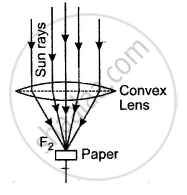Advertisements
Advertisements
प्रश्न
Can one bum a piece of paper in daylight by just using a convex lens instead of a match or any direct flame? Support your answer with the help of an appropriate ray diagram.
उत्तर
Yes, it is possible to burn a piece of paper, in daylight, by using a convex lens instead of a match or any other direct flame.

We know that a convex lens brings a beam of parallel incident rays to a focus at its focal point. The rays of the sun (practically an infinite distance source) form a parallel incident beam. When they are allowed to fall on a convex lens, they get focussed at its focal point. If a piece of paper is kept at this focal point, all the (large) heat energy of this parallel beam gets concentrated at this point. This (concentrated heat energy) is often sufficient to burn the piece of paper. The required ray diagram is as shown in the figure.
APPEARS IN
संबंधित प्रश्न
To find the image-distance for varying object-distances in case of a convex lens, a student obtains on a screen a sharp image of a bright object placed very far from the lens. After that he gradually moves the object towards the lens and each time focuses its image of the screen.
(a) In which direction – towards or away from the lens, does he move the screen to focus the object?
(b) What happens to the size of image – does it increase or decrease?
(c) What happen when he moves the object very close to the lens?
What is the position of image when an object is placed at a distance of 10 cm from a convex lens of focal length 10 cm?
A convex lens of focal length 6 cm is held 4 cm from a newspaper which has print 0.5 cm high. By calculation, determine the size and nature of the image produced.
Find the nature, position and magnification of the images formed by a convex lens of focal length 0.20 m if the object is placed at a distance of:
0.50 m
The diagrams (a) and (b) in Figure below show the refraction of a monochromatic ray of light through a parallel sided glass block and a prism respectively. In each diagram, label the incident, refracted emergent rays and the angle of deviation.

In the following cases, where must an object be placed in front of a convex lens so that the image formed is at infinity?
A lens always forms an image between the object and the lens.
A lens always forms an image between the object and the lens.
Answer the following question.
List four precautions which a student should observe while determining the focal length of a given convex lens by obtaining an image of a distant object on a screen.
Simple microscope : Number of convex lens one : : compound microscope : _______
Distinguish between Concave lens and Convex lens.
